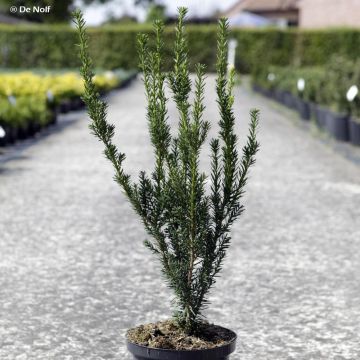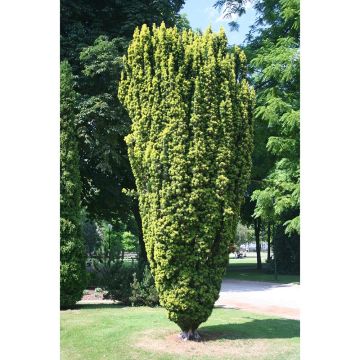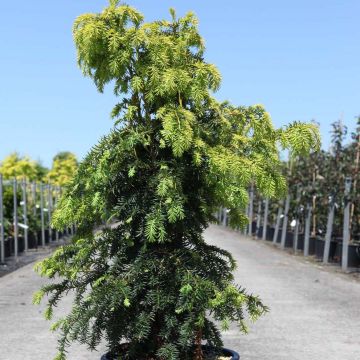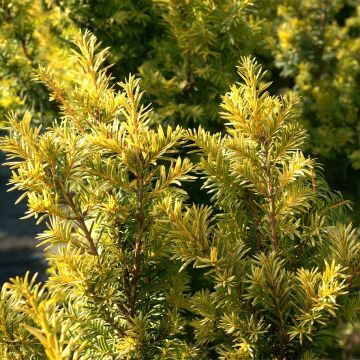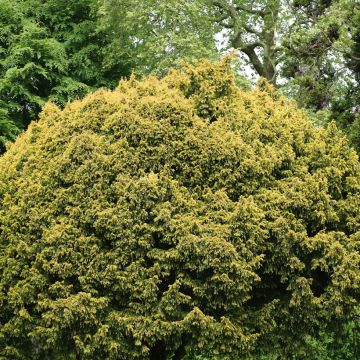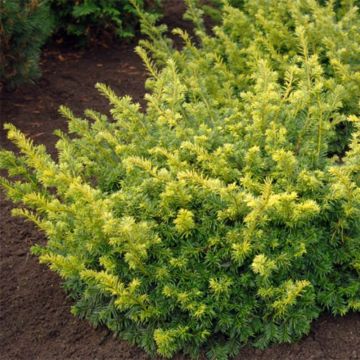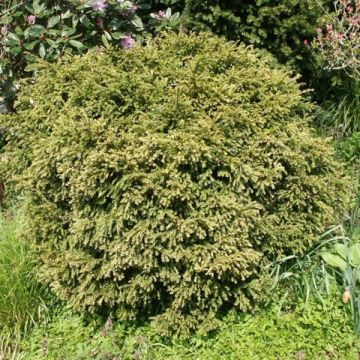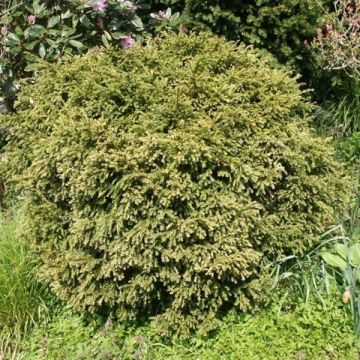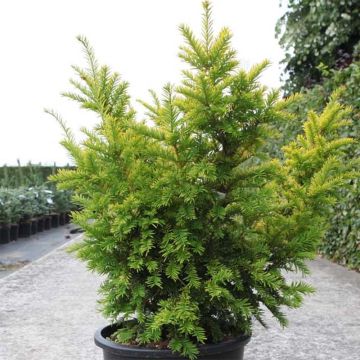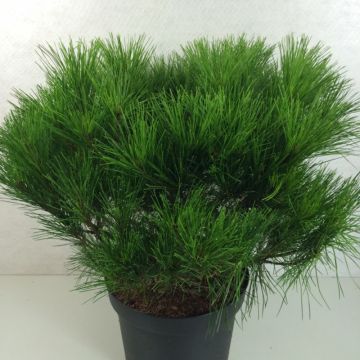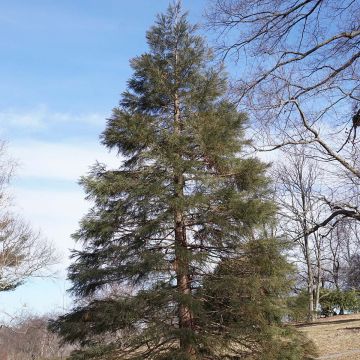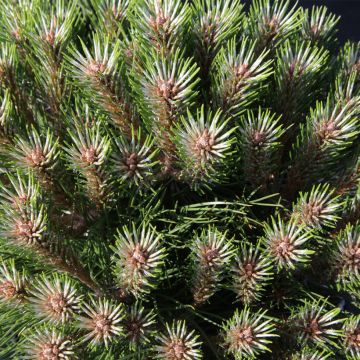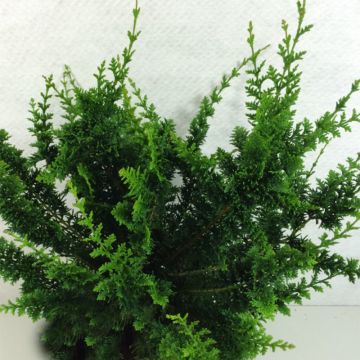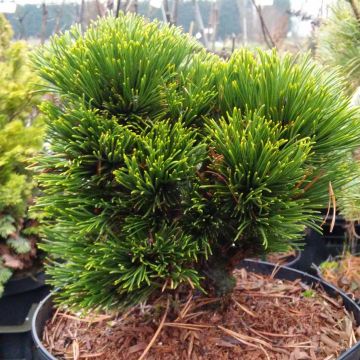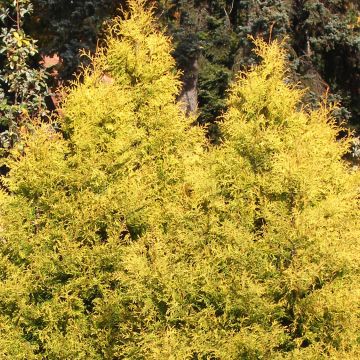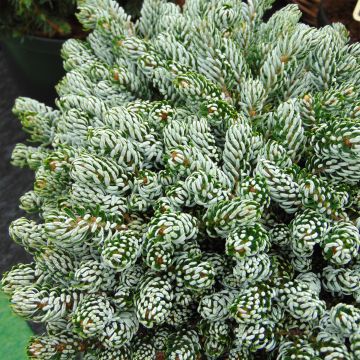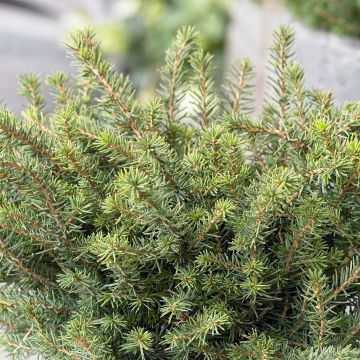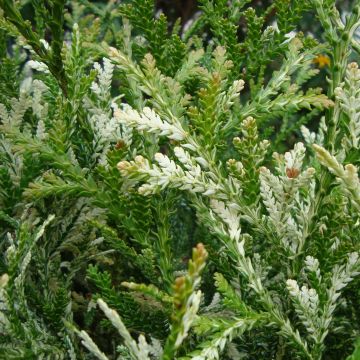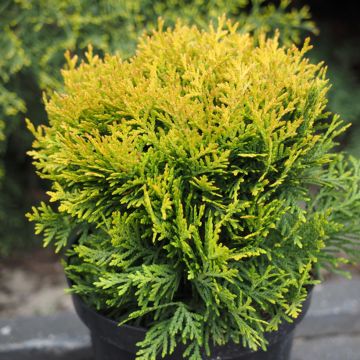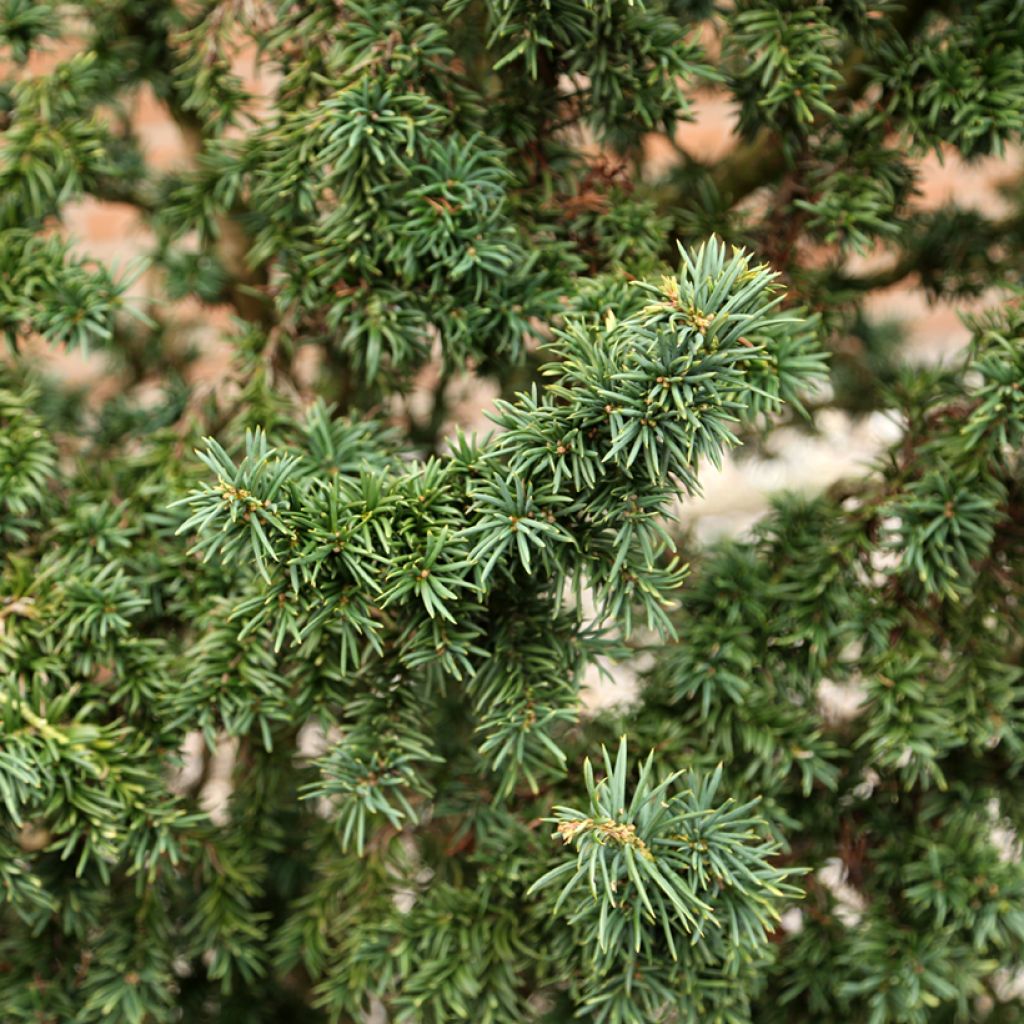

Taxus baccata Cristata - Yew
Taxus baccata Cristata - Yew
Taxus baccata Cristata
Yew, Common Yew, English Yew
This item cannot be shipped to the selected country
Delivery charge from €5.90
More information
Schedule delivery date,
and select date in basket
This plant carries a 24 months recovery warranty
More information
We guarantee the quality of our plants for a full growing cycle, and will replace at our expense any plant that fails to recover under normal climatic and planting conditions.
From €5.90 for pickup delivery and €6.90 for home delivery
Express home delivery from €8.90.
Does this plant fit my garden?
Set up your Plantfit profile →
Description
Taxus baccata 'Cristata' is a dwarf form of the common yew, remarkable for its unique appearance and many advantages. Appreciated for its charming habit, dense evergreen foliage, and twisted branches, this variety of yew is decorative in every season. It is also a very versatile plant that can be grown in rock gardens, Japanese or French gardens, as well as in containers on terraces or balconies.
Taxus baccata 'Cristata' belongs to the Taxaceae family. This cultivar is known for its slow growth, reaching about 0.8m in height and width in 10 years, and up to 1.5m in height and 1m in spread at maturity. Its habit is irregular, more or less bushy, narrow and upright, with sinuous central shoots and somewhat wayward lateral shoots. The bark of the stems is twisted and furrowed. Its 3 to 4 cm needles are light green in spring and then become dark green. They are also slightly twisted, accentuating the sinuous, bizarre, and twisted aspect of the plant.
Very present in the oldest gardens and parks in Europe, yews (Taxus baccata) sometimes watch over us for hundreds of years. Their longevity is indeed remarkable and can reach several centuries. The wild species, which has become rare in nature, is native to Europe, Asia Minor, and North Africa. Some specimens are said to be over a thousand years old. You can also admire impressive specimens in old gardens or in cemeteries, near churches, for symbolic reasons, as the yew is considered to be the link between heaven and earth. The needles, bark, and fruits are toxic to humans and animals, except for birds that consume the berries and discard the seeds. The common yew is a conifer of the Taxodiaceae family, just like cryptomerias and metasequoias.
Taxus baccata 'Cristata' is an accent plant, perfect for creating texture effects in rock gardens as well as small gardens. In containers, it enhances terraces and balconies. This small conifer pairs particularly well with heathers and dwarf conifers with trailing habits, such as Juniperus horizontalis 'Blue Chip'. Consider incorporating small grasses like Festuca glauca 'Elijah Blue' among these plants. Together, these plants create harmonious compositions that are interesting throughout the year.
Report an error about the product description
Plant habit
Foliage
Safety measures
Botanical data
Taxus
baccata
Cristata
Taxaceae
Yew, Common Yew, English Yew
Cultivar or hybrid
ingestion
Cette plante est toxique si elle est ingérée volontairement ou involontairement.
Ne la plantez pas là où de jeunes enfants peuvent évoluer, et lavez-vous les mains après l'avoir manipulée.
Pensez à conserver l'étiquette de la plante, à la photographier ou à noter son nom, afin de faciliter le travail des professionnels de santé.
Davantage d'informations sur https://plantes-risque.info
Other Taxus - Yew
Planting and care
Plant the Dwarf Yew 'Cristata' preferably in autumn or spring rather than winter like other evergreens. Larger specimens can be easily established in well-prepared soil. Dig a spacious planting hole that is much wider than the root ball, without burying the base of the trunk. Water generously to facilitate establishment. Monitor watering during the first two or three years of cultivation, especially in dry weather, but without excess. The Common Yew is truly undemanding, and that is one of its most beautiful qualities. It thrives in full sun or partial shade, and can even tolerate shade in hot climates, in ordinary soil, well loosened at planting, slightly alkaline or acidic, and moist to dry in summer. It easily adapts to all climates and soils. It can be pruned twice a year, in spring and autumn (the latter allowing for adjustment of the former), in April and August (depending on your climate). The fastigiate yew withstands wind well, but not sea spray. It tolerates urban pollution well but is sensitive to de-icing salt. This conifer is not very susceptible to diseases, although it can sometimes be infested with scale insects and its roots can be attacked by weevil larvae or, in damp soil, by fungi.
Planting period
Intended location
Care
This item has not been reviewed yet - be the first to leave a review about it.
Conifers
Haven't found what you were looking for?
Hardiness is the lowest winter temperature a plant can endure without suffering serious damage or even dying. However, hardiness is affected by location (a sheltered area, such as a patio), protection (winter cover) and soil type (hardiness is improved by well-drained soil).

Photo Sharing Terms & Conditions
In order to encourage gardeners to interact and share their experiences, Promesse de fleurs offers various media enabling content to be uploaded onto its Site - in particular via the ‘Photo sharing’ module.
The User agrees to refrain from:
- Posting any content that is illegal, prejudicial, insulting, racist, inciteful to hatred, revisionist, contrary to public decency, that infringes on privacy or on the privacy rights of third parties, in particular the publicity rights of persons and goods, intellectual property rights, or the right to privacy.
- Submitting content on behalf of a third party;
- Impersonate the identity of a third party and/or publish any personal information about a third party;
In general, the User undertakes to refrain from any unethical behaviour.
All Content (in particular text, comments, files, images, photos, videos, creative works, etc.), which may be subject to property or intellectual property rights, image or other private rights, shall remain the property of the User, subject to the limited rights granted by the terms of the licence granted by Promesse de fleurs as stated below. Users are at liberty to publish or not to publish such Content on the Site, notably via the ‘Photo Sharing’ facility, and accept that this Content shall be made public and freely accessible, notably on the Internet.
Users further acknowledge, undertake to have ,and guarantee that they hold all necessary rights and permissions to publish such material on the Site, in particular with regard to the legislation in force pertaining to any privacy, property, intellectual property, image, or contractual rights, or rights of any other nature. By publishing such Content on the Site, Users acknowledge accepting full liability as publishers of the Content within the meaning of the law, and grant Promesse de fleurs, free of charge, an inclusive, worldwide licence for the said Content for the entire duration of its publication, including all reproduction, representation, up/downloading, displaying, performing, transmission, and storage rights.
Users also grant permission for their name to be linked to the Content and accept that this link may not always be made available.
By engaging in posting material, Users consent to their Content becoming automatically accessible on the Internet, in particular on other sites and/or blogs and/or web pages of the Promesse de fleurs site, including in particular social pages and the Promesse de fleurs catalogue.
Users may secure the removal of entrusted content free of charge by issuing a simple request via our contact form.
The flowering period indicated on our website applies to countries and regions located in USDA zone 8 (France, the United Kingdom, Ireland, the Netherlands, etc.)
It will vary according to where you live:
- In zones 9 to 10 (Italy, Spain, Greece, etc.), flowering will occur about 2 to 4 weeks earlier.
- In zones 6 to 7 (Germany, Poland, Slovenia, and lower mountainous regions), flowering will be delayed by 2 to 3 weeks.
- In zone 5 (Central Europe, Scandinavia), blooming will be delayed by 3 to 5 weeks.
In temperate climates, pruning of spring-flowering shrubs (forsythia, spireas, etc.) should be done just after flowering.
Pruning of summer-flowering shrubs (Indian Lilac, Perovskia, etc.) can be done in winter or spring.
In cold regions as well as with frost-sensitive plants, avoid pruning too early when severe frosts may still occur.
The planting period indicated on our website applies to countries and regions located in USDA zone 8 (France, United Kingdom, Ireland, Netherlands).
It will vary according to where you live:
- In Mediterranean zones (Marseille, Madrid, Milan, etc.), autumn and winter are the best planting periods.
- In continental zones (Strasbourg, Munich, Vienna, etc.), delay planting by 2 to 3 weeks in spring and bring it forward by 2 to 4 weeks in autumn.
- In mountainous regions (the Alps, Pyrenees, Carpathians, etc.), it is best to plant in late spring (May-June) or late summer (August-September).
The harvesting period indicated on our website applies to countries and regions in USDA zone 8 (France, England, Ireland, the Netherlands).
In colder areas (Scandinavia, Poland, Austria...) fruit and vegetable harvests are likely to be delayed by 3-4 weeks.
In warmer areas (Italy, Spain, Greece, etc.), harvesting will probably take place earlier, depending on weather conditions.
The sowing periods indicated on our website apply to countries and regions within USDA Zone 8 (France, UK, Ireland, Netherlands).
In colder areas (Scandinavia, Poland, Austria...), delay any outdoor sowing by 3-4 weeks, or sow under glass.
In warmer climes (Italy, Spain, Greece, etc.), bring outdoor sowing forward by a few weeks.

































